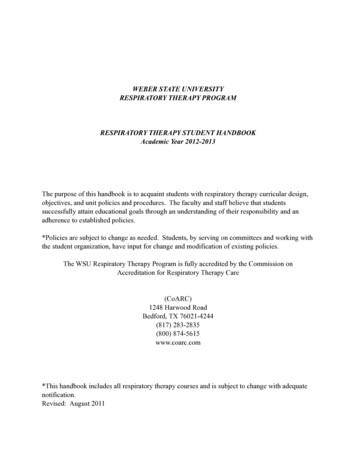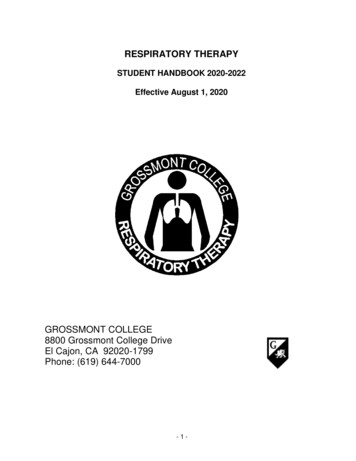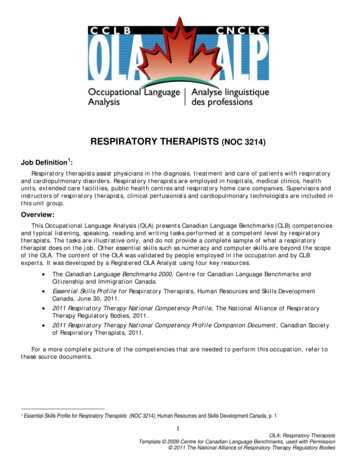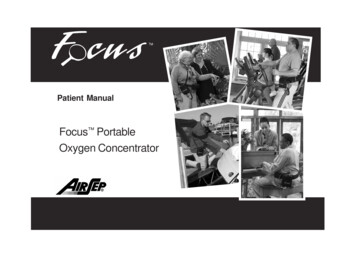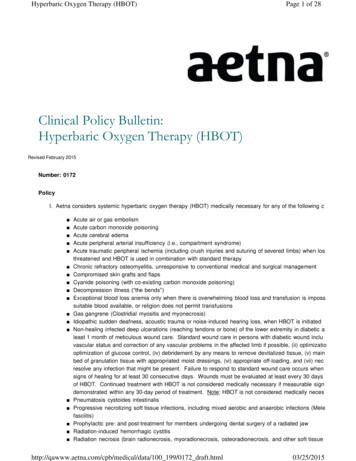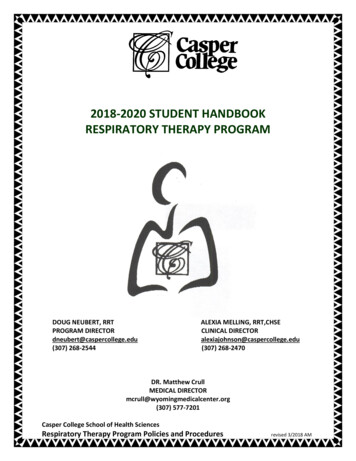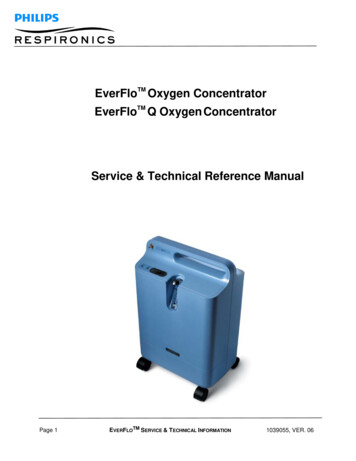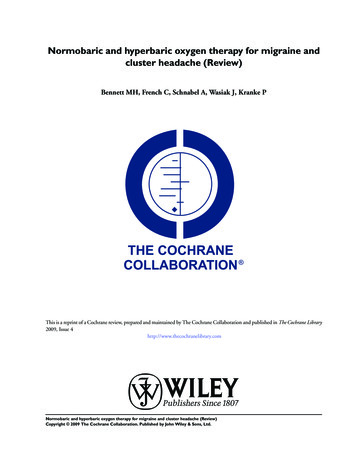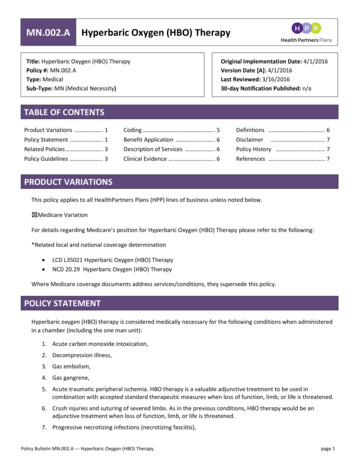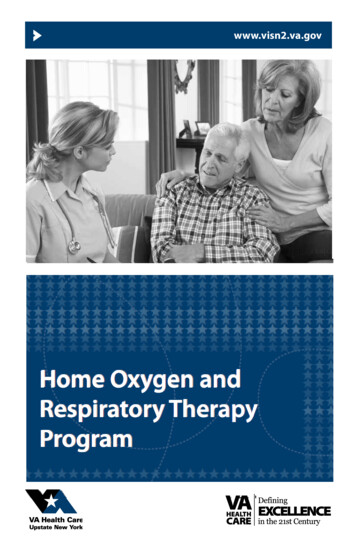
Transcription
www.visn2.va.govHome Oxygen andRespiratory TherapyProgram
Helping You Breathe EasierYour VA health care provider has ordered respiratory therapyequipment for your care at home. This can be a brief or long-termneed that you and your doctor should talk about.VA has a service contract with a certified medical home carecompany. With the approval of your home respiratory therapist,prosthetic services will arrange for equipment to be delivered andset up in your home.The technician must do safety checks and explain how to operateand care for your equipment we are providing.A respiratory therapist will visit within 24 hours of you receivinghome respiratory therapy services to see if you are doing okay andhave any questions or concerns about your respiratory home care. 2
Home Oxygen TherapyMore and more people are using oxygen therapy outside the hospital,letting them lead active, productive lives. You may receive oxygentherapy if you are having trouble breathing. Oxygen can help lessensleeplessness, headaches and improve mobility and mental ability.The PrescriptionA physician must write a prescription for oxygen therapy. Your physi cian will use blood test results that will indicate what your oxygen levelis and help determine what your needs are.Your flow rate:You may have more than one rate, depending on your activity.Flow rate for sleeping:Flow rate for exercise:Flow rate for normal activity:NeveR change the flow rate without your healthcare provider’s approval.The equipmentThere are three common ways of providing oxygentherapy. Oxygen can be delivered to your home in theform of a gas in various-sized cylinders or as a liquidcontainer. The third way to provide oxygen therapyis by using an oxygen concentrator. Each type hasdifferent advantages.Compressed Gas — Oxygen is stored under pressure in a cylinderequipped with a regulator that controls the flow rate. Because the flowof oxygen out of the cylinder is constant, an oxygen-conserving devicemay be attached to the system to avoid waste. This device releases thegas only when you inhale and cuts it off when you exhale. Oxygen isprovided in a small cylinder that can be carried with you, and in largetanks, which are heavy and are only suitable for stationary use. 3
Liquid Oxygen — Oxygen is stored as a very cold liquid in a containervery similar to a thermos. When released, the liquid converts to a gasand you breathe it in just like the cylinder gas. This storage methodtakes up less space than the compressed gas cylinder, and you cantransfer the liquid to a small, portable container at home. The liquidoxygen container vents when not in use. An oxygen conserving devicemay be built into the container to conserve the oxygen.Oxygen Concentrator — This is an electricallypowered device that separates the oxygenout of the air, concentrates it, and stores it. Thissystem has a number of advantages becauseit doesn’t have to be resupplied and it is not ascostly as liquid oxygen. Extra tubing permits theuser to move around with minimal difficulty. Youmust have a cylinder of oxygen as a backup inthe event of a power failure. You should adviseyour electric power company in order to getpriority service when there is a power failure.Your Portable OxygenIf your provider prescribed oxygen at 2liters per minute and you used the standard(back-up) regulator on a d size tank it wouldlast 3 hours and 27 minutes. This regulatorcomes with ALL HOME OXYGEN.If you use the conserving regulator yoursame tank would last 10 hours and 21minutes. The regulator shuts off while youexhale making more tank-time. When youinhale it delivers a burst and the 2 litersper minute. Conserving regulators are forVeterans who qualify clinically.STANDARDCONSERVING 4
Stay Safe Around Oxygen equipmentOxygen will not explode, but it will make a fire burn hotter. You should never smoke while using oxygen. Warn visitors not tosmoke near you when you are using oxygen. Put up “No Smoking”signs in your home where you most often use the oxygen.Stay at least five feet away from gas stoves, candles, lightedfireplaces, or other heat sources.Don’t use any flammable products like cleaning fluid, paint thinner,or aerosol sprays while using your oxygen.If you use a portable oxygen system, make sure it is secured to somefixed object or in a stand. Use a seatbelt/safety belt in the car tosecure portables.If you use liquid oxygen, make sure the container is kept upright tokeep the oxygen from pouring out; the liquid oxygen is so cold itcan hurt your skin.Keep a fire extinguisher close by and let your fire department knowthat you have oxygen in your home.If you are using an electric concentrator for your oxygen, contactyour local power company for their power failure policy. Somepower companies keep listings of patients with special needs. Youmay be directed to notify your community ambulance service or firedepartment with your special medical needs.Ensure your Fire Safety Valve is installed each time yourtubing is replaced. This device helps fires from reaching theoxygen supply source.You will be asked to sign a statement stating that you are awareof the extreme danger related to smoking around oxygen equipment. 5
Care of equipmentThe home medical equipment and services company that provides thetherapy to you at VA’s request will provide you with instructions on thecare and use of your equipment. Here are some general guidelines foryour cleaning procedures: You should wash your nasal prongs with a liquid soap and rinse wellonce or twice a week. Replace them every two to four weeks. If youhave a cold, change them when your cold symptoms have passed. The humidifier bottle should be washed with soap and warm waterand rinsed thoroughly between each refill. Air dry the bottle beforefilling with distilled water. If you use an oxygen concentrator, unplug the unit, then wipe downthe cabinet with a damp cloth and dry it at least weekly. The air filtershould be cleaned at least twice a week. Follow your home medicalequipment and services company’s directions for cleaning thecompressor filter.Care or Safety ConcernsIf you have a care or safety concern you are encouraged to seek helpfrom your local VA prosthetic representative. Every effort will be made toresolve the care or safety concern in a timely manner.If the care or safety concern remains unresolved, you may contact thelocal VA Medical Center Patient Advocate in Albany (518) 626-6934; Bath(607) 664-4797; Canandaigua (585) 393-7612; Rochester VA OutpatientClinic (585) 463-2653; Syracuse (315) 425-4345; VA Western New YorkHealthcare System at Batavia and Buffalo (716) 862-8752.If the care or safety concern remains unresolved, you may contact VAMedical Center Management at Albany (518) 626-6731; Bath (607) 664 4722; Buffalo (716) 862-8529; Canandaigua (585) 393-7208; Syracuse(315) 425-4892.If your issues continue to be unresolved through the management ofthe Medical Center, you may contact the Joint Commission. You maysend the Joint Commission your issue by mail, fax, or e-mail. You cancontact the Joint Commission via telephone weekdays, 8:30 a.m. to 5:00p.m. Central Time. 6
Mail: The Joint Commission Office of Quality MonitoringOne Renaissance BoulevardOakbrook Terrace, IL 60181Toll-Free Telephone: (800) 994-6610Fax:(630) n’t use alcohol or take any other sedating drugs because they willslow your breathing rate. Do make sure you order more oxygen from your dealer in a timelymanner. Do use water-based lubricants on your lips or nostrils. Don’t use anoil-based product like petroleum jelly. To prevent your cheeks or the skin behind your ears from becomingirritated, tuck some gauze under the tubing. If you have persistentredness under your nose, call your physician. Do find out how long your portable tank will last so if you go out youdo not run low. Call your VA prosthetic or respiratory therapist, 10 working daysahead, if you plan to travel a distance away from home and needoxygen equipment set-up/delivered. TroubleCall your primary care provider/team if you have: Constant headaches Blue lips or fingernails Drowsiness Confusion Restlessness Anxiety Slow, shallow, difficult, or irregular breathing Fever, chills Change in sputum color (yellow/green) or other lung infectionsymptoms. 7
Home CareRespiratory care at home can contribute to improved quality of life.Your respiratory care practitioner can help you with your treatment,answer questions, provide instructions, and offer suggestions. Here aresome tips to ensure that you get the greatest benefit from your respira tory home care.Get InvolvedAsk questions of your physician, respiratory care practitioner, dischargeplanner, and if necessary, your home medical equipment supplier.Discuss all the options that are available to you regarding your careplan. Provide all the information that is requested about your family andhome situation to help your health care provider plan for your care.Infection ControlPreventing infections can help you stay as healthy as possible. Handwashing is the single most important thing to perform on a routinebasis. Use soap and lots of warm running water. Work up a good latherand scrub for at least 15 seconds. Rinse well, with your hands pointeddown to keep the dirty water from running up your arms. Dry yourhands with a clean paper or cloth towel.Your respiratory care equipment should be cleaned on a regular basis,besides washing with a mild detergent and rinsing carefully.If you have a home nebulizer it is necessary to sanitize your equipmentin a vinegar solution of one part vinegar to three parts distilled water.Rinse carefully and let the parts air dry on a clean cloth or towel.If you use a metered-dose inhaler and/or a spacer, it should be rinsedwith warm water and sanitized as directed by your health care provider.These are only guidelines, and the specific directions for cleaning andsanitizing your home medical equipment is part of the instructions youwill get from your home medical equipment company. 8
Patient Rights and Responsibilities in the VARespiratory Therapy Home Care ProgramYou are eligible for vA respiratory therapy home care. In acceptingthe vA’s assistance with equipment and expenses you agree to thefollowing:You have the right to:1. Be given information about your rights and responsibilities forreceiving VA respiratory therapy home care services.2. Be given appropriate and professional quality home services with out discrimination against race, color, religion, sex, national origin,sexual orientation, handicap or age.3. Be treated with courtesy and respect by all who provide home careto you under this program.4. Be free from physical and mental abuse and neglect.5. Be given proper identification (name and title) by everyone whoprovides oxygen/equipment services to you.6. Receive a timely response regarding any request for home careservices under this program.7. Be given privacy and confidentiality.8. Participate in the development of your plan of care and be given anassessment and update periodically.9. Voice grievances with and/or suggest changes in respiratorytherapy home care services and/or staff without being threatened,restrained, or discriminated against.10. Be given information concerning the consequences of refusingtreatment.11. Refuse treatment within the confines of the law. 9
Your Responsibilities in the vA Respiratory Therapy HomeCare Program1. Allow home care personnel in your residence for scheduledappointments/deliveries.2. Be courteous to personnel providing the home care and keepscheduled appointments with them.3. Keep your scheduled medical appointments for evaluation of theneed for continued respiratory therapy home care.4. Follow your practitioner’s and home care respiratory therapist’s planof care and instructions in equipment safety/use.5. Contact your local VA home oxygen coordinator within 14 daysof your intent to travel out of the area. VA will do our best toaccommodate emergency travel but 14 days is required for non emergency travel.6. Contact your local home oxygen coordinator if you no longer needVA respiratory services or equipment.7. If you smoke and would like to quit, contact your primary careprovider to request enrollment in a smoking cessation program.8. Patients on Oxygen **DO NOT Smoke - smoking stops thebenefits of oxygen therapy and is a fire hazard. Patients on oxygenmust NEVER smoke while oxygen therapy is in use. Patients onoxygen are encouraged to quit smoking.9. If you have questions or concerns about access to care, medicaltreatment, follow-up care or medications, after normal businesshours, weekends, or holidays, please contact TelCare at:(888) 838-7890.vA Respiratory TherapyHome Care vendorApnea Care Inc.1120 Youngs RoadWilliamsville, NY 142211-855-672-7632Getting the Support You NeedAmerican Lung Association:(800) LUNG USA / (800) 586-4872National Heart, Lung andBlood Institute:(301) 592-8573 10
vA Respiratory Therapy/Home Oxygen ContactAlbany Stratton VA Medical Center(518) 626-6430 or (518) 626-6411VA Western NY Healthcare System (Batavia)(585) 297-1080Bath VA Medical Center(607) 664-4622VA Western NY Healthcare System (Buffalo)(716) 862-7310Canandaigua VA Medical Center(585) 393-7296After Hours Medical Advice Line TelCare(888) 838-7890Rochester VA Outpatient Clinic585-463-2600 ext. 32523Syracuse VA Medical Center(315) 425-4400 ext. 52831 or 52830 or 53290Caregiver Support1-855-260-3274For help with caring for a disabled Veteranwww.caregiver.va.govHealth Information on the Webwww.myhealth.va.govNational Call Center for Homeless Veterans Hotline1-877-4AID-VET / 1-877-424-3838TelCare1-888-838-789024-hour, toll-free medical advice for enrolled VeteransVeterans Crisis Line1-800-273-8255 press “1”www.veteranscrisisline.netVeterans Service Contact Center1-888-823-9656For information on eligibility, VA health care benefits, enrollment,or questions on your billing statementE-Donatewww.visn2.va.govYou can now make a donation online to the Veteran program of your choiceProduced by VA Health Care Upstate New York / Public Affairs OfficeDesigned and printed exclusively by the Network 2 Print Shop, Bath VA Medical Center. All rights reserved.6/13 11
Reaching Us Is EasyVA Medical CentersWestportAlbany113 Holland AvenueAlbany, NY 12208(518) 626-5000Clifton Park1673 Route 9Clifton Park, NY 12065(518) 626-5205Batavia222 Richmond AvenueBatavia, NY 14020(585) 297-1000Coudersport SatelliteClinic of Wellsville24 Maple View Lane, Suite 2Coudersport, PA 16915(814) 260-9342Bath76 Veterans AvenueBath, NY 14810(607) 664-4000Buffalo3495 Bailey AvenueBuffalo, NY 14215(716) 834-9200Canandaigua400 Fort Hill AvenueCanandaigua, NY 14424(585) 394-2000(800) 204-9917Syracuse800 Irving AvenueSyracuse, NY 13210(315) 425-4400Community-BasedOutpatient ClinicsAuburnAuburn Memorial Hospital17 Lansing St.Auburn, NY 13021(315) 255-7002DunkirkValor Health Center166 East 4th StreetDunkirk, NY 14048(800) 310-5001ElmiraHealth Services Building200 Madison AvenueSuite 2EElmira, NY 14901(877) 845-3247 ext. 44640FondaCamp Mohawk Plaza2623 State Highway 30AFonda, NY 12068(518) 853-1247Glens Falls84 Broad StreetGlens Falls, NY 12801(518) 798-6066Jamestown608 West 3rd StreetJamestown, NY 14701(716) 338-1511Bainbridge109 North Main StreetBainbridge, NY 13733(607) 967-8590Kingston63 Hurley AvenueKingston, NY 12401(845) 331-8322Binghamton425 Robinson StreetBinghamton, NY 13901(607) 772-9100LackawannaOur Lady of VictoryFamily Care Center227 Ridge RoadLackawanna, NY 14218(716) 822-5944CatskillGreene Medical Bldg.159 Jefferson HeightsCatskill, NY 12414(518) 943-7515Springville SatelliteClinic of Lackawanna27 Franklin StreetSpringville, NY 14141(716) 592-7400Lockport5883 Snyder DriveLockport, NY 14094(716) 438-3890Malone3372 St. Rt. 11, Main StreetMalone, NY 12953(518) 483-1529Mansfield SatelliteClinic of Elmira63 Third StreetSuite 104Mansfield, PA 16901(570) 662-0507Massena1 Hospital DriveMassena, NY 13662(315) 769-4253Niagara Falls2201 Pine AvenueNiagara Falls, NY 14301(716) 862-8580Olean465 North Union StreetOlean, NY 14760(716) 373-7709Oswego437 State Route 104EOswego, NY 13126(315) 207-0120Plattsburgh80 Sharron AvenuePlattsburgh, NY 12901(518) 561-6247Rochester465 Westfall RoadRochester, NY 14620(585) 463-2600RomeGriffiss Park125 Brookley Road,Building 510Rome, NY 13441(315) 334-7100Saranac Lake33 Depot St.Saranac Lake, NY 12983(518) 626-5237Schenectady1322 Gerling St.Sheridan PlazaSchenectady, NY 12308(518) 346-3334Tompkins/Cortland County1451 Dryden RoadFreeville, NY 13068(607) 347-4101Troy295 River StreetTroy, NY 12180(518) 274-7707Watertown19472 U.S. Route 11Watertown, NY 13601(315) 221-7026Wellsville3458 Riverside Drive, Route19Wellsville, NY 14895(877) 845-3247 (Bath)Westport/Elizabethtown7426 NYS Rte. 9NWestport, NY 12993(518) 626-5236
Respiratory Therapy Home Care Program You are eligible for vA respiratory therapy home care. In accepting the vA's assistance with equipment and expenses you agree to the following: You have the right to: 1. Be given information about your rights and responsibilities for receiving VA respiratory therapy home care services. 2.
